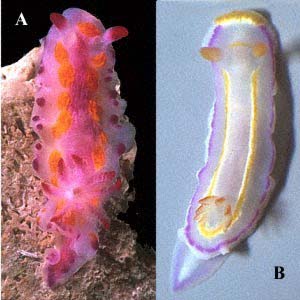
Thorunna florens
(Baba, 1949)
Order: NUDIBRANCHIA
Suborder: DORIDINA
Family: Chromodorididae
DISTRIBUTION
Tropical western Pacific from Japan to Australia; eastern Indian Ocean (Thailand, Western Australia).
PHOTO
UPPER: A, Rocky Bluff, Enderby Island, Dampier Archipelago, Western Australia, April 1987. (6mm long preserved) PHOTO: Clay Bryce. B, Hong Kong, China, April 1989, (9mm long preserved) PHOTO: Brian Darvell.
LOWER LEFT: Western Australian specimen with egg mass. PHOTO: Clay Bryce.
LOWER RIGHT: Phi Phi Is, Thailand, November 1989, C162380. PHOTO: D.J. Brunckhorst.
RELATED TOPIC
Thorunna? sp. 1 from Western Australia
Originally described from Japan, the animal illustrated above from Hong Kong looks very similar to the many reports from Japan. In Japanese specimens the purple submarginal line is broken into a string of diffuse spots or patches much like in the Thailand specimen. I consider the Western Australian specimens to represent a colour form rather than a separate species as their internal anatomy is identical to that of the Hong Kong and Japanese specimens. See messages below for discussion of the Thailand specimen.
References:
• Baba, K., 1988. Anatomical information on Thorunna (=Babaina) (Nudibranchia: Chromodorididae) from Toyama Bay and vicinity, Japan. The Veliger, 30: 325-328. [lists earlier Japanese references].
• Rudman,W.B. 1990. The Chromodorididae (Opisthobranchia: Mollusca) of the Indo-West Pacific: further species of Glossodoris, Thorunna and the Chromodoris aureomarginata colour group. Zoological Journal of the Linnean Society, 100: 263-326.
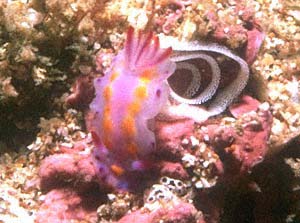
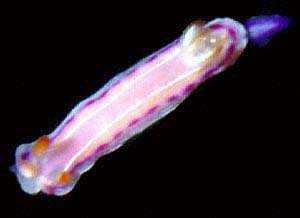
Rudman, W.B., 1998 (November 11) Thorunna florens (Baba, 1949). [In] Sea Slug Forum. Australian Museum, Sydney. Available from http://www.seaslugforum.net/find/thorflor
Related messages
Re:Thorunna florens from Tulamben, Bali
October 29, 2008
From: Marcel Tanke

Concerning message #20788:
Hi Bill,
Here are another 2 pictures of Thorunna florens from Tulamben. There is quite some difference in body shape. The first one much more round than the second.
Locality: Tulamben, Bali, about 15 m, Indonesia, 30 September 2008, black sand. Length: 2 cm. Photographer: Marcel Tanke.
Best regards,
Marcel
marceltanke@cs.com
Tanke, M.A., 2008 (Oct 29) Re:Thorunna florens from Tulamben, Bali. [Message in] Sea Slug Forum. Australian Museum, Sydney. Available from http://www.seaslugforum.net/find/21991
Thanks Marcel,
Because they have no hard skeleton, shape in these animals is quite changeable. They can be quite elongate when moving but much shorter and wider when at rest or when feeding. Its possible the animal in the upper photo is feeding but I can't make out enough detail to be sure.
Best wishes,
Bill Rudman
Thorunna florens from Tulamben, Bali
October 24, 2008
From: Fiona Kwok

I'm not sure what this is apart from it being a nudibranch. Have not found it in any of my nudi reference books.
Locality: Tulamben, Drop Off, , 10 - 12 metres, Bali, Indonesia, Bali Sea, 19 August 2007, Sandy with some rocks and small coral bommies. Length: 2 inches. Photographer: Fiona Kwok.
Appreciate it if you could advise.
Many thanks,
Fiona
fi.kwok@gmail.com
Kwok, F, 2008 (Oct 24) Thorunna florens from Tulamben, Bali. [Message in] Sea Slug Forum. Australian Museum, Sydney. Available from http://www.seaslugforum.net/find/20788
Dear Fiona,
This is Thorunna florens. As we are still wondering just how much colour variation there is in this species, it is good to get a couple more photos.
Best wishes,
Bill Rudman
Thorunna florens ? from Tulamben, Bali.
September 9, 2008
From: Vie Panyarachun

Hi Dr. Rudman,
I'm guessing this is a Thorunna florens.?
Locality: "Drop Off," near Mimpi Resort Tulamben, 4m, Bali, Indonesia, Bali Sea, 24 August 2008, Sandy. Length: Approx. 1 inch. Photographer: Vie Panyarachun.
Would appreciate an ID please.
Sincerely,
Vie
vpanyarachun@hotmail.com
Panyarachun, Vie, 2008 (Sep 9) Thorunna florens ? from Tulamben, Bali.. [Message in] Sea Slug Forum. Australian Museum, Sydney. Available from http://www.seaslugforum.net/find/21840Dear Vie,
Yes this is T. florens.
Best wishes,
Bill Rudman
Thorunna florens from sthn Queensland
September 27, 2007
From: Gary Cobb
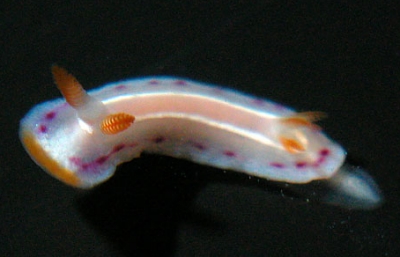
Hi Bill and everyone!
I thought you might like a record of Thorunna australis from southern Queensland. This the second one we have found. Very small. Noticed that the gills don't seem to be in a full circle. Also noticed that the rhinophores don't have a band!
Locality: Mooloolaba Sunshine Coast, 15 m, Queensland, Australia, Pacific Ocean, 22 September 2007, Subtidal. Length: 12 mm. Photographer: Gary Cobb.
Cheers
Gary Cobb
gary@nudibranch.com.au
Cobb, G.C., 2007 (Sep 27) Thorunna florens from sthn Queensland. [Message in] Sea Slug Forum. Australian Museum, Sydney. Available from http://www.seaslugforum.net/find/20783
Dear Gary,
This is Thorunna florens rather than T. australis. You had noticed the lack of a band on the rhinophores. Also the orange patch on the front of the mantle is characteristic of T. florens. In T. australis, the mantle is much narrower and the outer row of purple spots is very close to the white lines.
Best wishes,
Bill Rudman
Thorunna florens from Noumea?
September 7, 2007
From: Yves Gillet

Dear Dr Rudman,
I found this pretty dorid at a depth of ten metres, on soft bottom, near Nouméa, the 28 of november. It measures about 10 millimeters. Maybe it's a Hypselodoris (or a juvenile?) but I can't identify it.
Locality: Nouméa, 10 metres, New Caledonia, Pacific Ocean, 28 november 2006. Length: 10 mm. Photographer: Yves GILLET.
Thank you for your help.
Sincerely.
Yves Gillet.
pym@mls.nc
Gillet, Y., 2007 (Sep 7) Thorunna florens from Noumea?. [Message in] Sea Slug Forum. Australian Museum, Sydney. Available from http://www.seaslugforum.net/find/18992Dear Yves,
I am pretty sure this is Thorunna florens, which is quite variable in colour. Have a look a Bob Bolland's message [#1412] of a quite similar animal from Okinawa.
Best wishes,
Bill Rudman
Thorunna florens? from Lembeh strait
January 3, 2007
From: Heidi Hösel

Dear Bill,
Maybe you can help me identify this tiny chromodorid found by my husband in Lembeh strait. At first glance, I considered it to be a Noumea or Durvilledoris species, but the colour pattern did not fit into any one of these categories.
The tiny white lateral double line together with the dark blue lining around the mantle edge distinguish this specimen from the purple Noumea, Thorunna, Durvilledoris and Hypselodoris species I have so far seen. Also the rhinophores (transparent base, red upper half with a pale blotch inside) seem uncommon to me.
Locality: Hairball 3, Lembeh strait, N-Sulawesi, about 14m, Indonesia, Pacific, 26 August 2006, sandy, silty slope. Length: 1,5cm. Photographer: Hermann Ernicke.
Thank you and best greetings
Heidi Hösel
hhoesel@gmx.de
Hösel, H., 2007 (Jan 3) Thorunna florens? from Lembeh strait. [Message in] Sea Slug Forum. Australian Museum, Sydney. Available from http://www.seaslugforum.net/find/18989
Dear Heidi,
This has similarities to quite a few chromodorids including Thorunna kahuna, Thorunna cf. australis and many in the Noumea purpurea colour group. I find that if the colour pattern is not a clear indicator, then the first step needed to identify these small elongate chromodorids is to have a look at the radula so that we can decide which genus the animal belongs to. External clues are quite difficult in many of these species. I think however that this is the same as an animal in Dave Harasti's message [#11613] which I think is most probably a colour variant of Thorunna florens.
Best wishes,
Bill Rudman
Thorunna florens from Nelson Bay
December 6, 2003
From: Dave Harasti

Hi Bill,
I found this nudibranch on 4 Dec 2003 at Little Beach in Nelson Bay, New South Wales - Australia. The animal was about 2 cm in length and was found at a depth of 5 metres. Water temp was about 21 degrees.
I think it is Thorunna florens. Is this correct?
Regards,
Dave
diving@webone.com.au
![]()

Thanks Dave,
It certainly falls into the group I am identifying at present as Thorunna florens.
Best wishes
Bill Rudman
Thorunna florens from Port Stephens, NSW
May 8, 2003
From: David & Leanne Atkinson
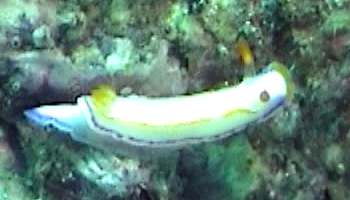
Hi Bill,
Do you have any idea what this nudi is. Sorry about the quality of the picture, it has been taken from video. We were out of film when we found it. We found it in 10m at Halifax Park, Port Stephens, NSW, Australia. December 2002.
David & Leanne Atkinson
atk@hunterlink.net.au
Atkinson, D. & Atkinson, L., 2003 (May 8) Thorunna florens from Port Stephens, NSW. [Message in] Sea Slug Forum. Australian Museum, Sydney. Available from http://www.seaslugforum.net/find/9873Dear David & Leanne,
This is an interesting find. It is almost identical to the photo of Thorunna florens from Hong Kong that I have on the species Fact Sheet. As you will see on that page, we have had colour forms of this species from Australia before, but never one that matches the 'typical' NW Pacific colour form so well.
Best wishes,
Bill Rudman
Thorunna florens from Korea
June 16, 2002
From: Dong Bum Koh

Dear Bill.
Here is a photo Thorunna florens from Korea for the Forum.
Data: Mun islet southeast of Cheju Island, southern Korea. Photo: Dong Bum Koh
With Best Regards.
Dong Bum, Koh
http://www.seasee.co.kr/2000default01.asp
drkoh@seasee.co.kr
Koh, D.B., 2002 (Jun 16) Thorunna florens from Korea. [Message in] Sea Slug Forum. Australian Museum, Sydney. Available from http://www.seaslugforum.net/find/7190Dear Dr Koh,
Thanks for this photo. It is good to see the colour variability in this species.
Best wishes,
Bill Rudman
Thorunna cf. florens from South Australia
April 26, 2002
From: John Chuk
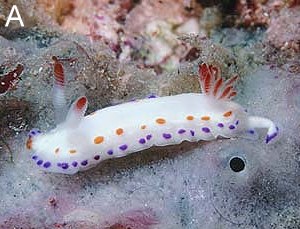
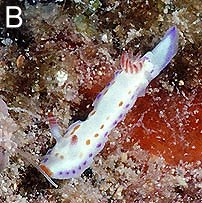
Dear Bill,
Here are images of two specimens of Thoruna cf. florens found at Rapid bay Jetty, South Australia. These are the only specimens I've seen of this species and they are identical to the specimen found by Stuart Hutchison at the same site.
UPPER: Is a specimen 14mm in length, found 31 January 2002, on a jetty pylon at a depth of 8.5m. This specimen has damage to the mantle margin and the red-brown spot on the anterior border is partially missing. At first I thought it might have been a form of Digidentis perplexa.
LOWER: Another specimen 14mm in length found on 1 February 2002. It was found actively crawling over rubble on the bottom beneath the jetty at a depth of 9m. This specimen has an intact mantle and the anterior red-brown spot is obvious.
Best wishes,
John
jchuk@giant.net.au
Chuk, J., 2002 (Apr 26) Thorunna cf. florens from South Australia. [Message in] Sea Slug Forum. Australian Museum, Sydney. Available from http://www.seaslugforum.net/find/6642Thanks John,
It is certainly consistent in colour. As I discussed with Stuart, its anatomy certainly fits that of T. florens, but as with many of these puzzles, more information is needed.
Best wishes,
Bill Rudman
Re: Thorunna cf. florens from South Australia
January 28, 2000
From: Stuart Hutchison
Bill,
I was scanning one of Neville Coleman's older publications the other night at a friend's place when I saw the animal in my photo listed as Chromodoris perplexa. Is that more likely given the disimilarity in appearance between the sample pictures on the Thorunna florens page ??
Regards,
Stuart
hutchco@tpg.com.au
Hurchison, S., 2000 (Jan 28) Re: Thorunna cf. florens from South Australia. [Message in] Sea Slug Forum. Australian Museum, Sydney. Available from http://www.seaslugforum.net/find/1792Dear Stuart,
I guess you are referring to Willan & Coleman, 1984. The photo there is definitely of Digidentis perplexa although it is of a much whiter animal than the normal translucent colour usually found in that species. I have dissected an identically coloured specimen and can find no anatomical differences.
Your animal is certainly similarly coloured, but I don't think it is the same. As I said in my earlier
comments, the mantle edge in your animal forms a wide flap and shows no sign of mantle glands, whereas in the Willan & Coleman photo, the mantle edge is very narrow and there are signs of a thick band of glands around the edge, which is typical of D. perplexa.
That is not to say that I definitely think your animal is Thorunna florens. At the moment that page has a collection of 'species', 'colour forms', call them what you may, which I think from experience are probably related. However until we get some anatomical information it is only a guess. Apart from the absence? or paucity of mantle glands, the orange mark at the anterior end of the mantle is beginning to look like a feature found in a number of species of Thorunna, including Thorunna montrouzieri, Thorunna sp. 1., Thorunna speciosus, as well as Thorunna florens.
The Thorunna florens page is a good example of taxonomic research 'in progress'. There is definitely no final word and until more material is available there is no prospect of resolving the question. However it is much better to leave it as a 'problem' than to rush out and name every colour 'form' as a new species.
As I also mentioned earlier, some groups of chromodorid nudibranchs show a remarkable ability to evolve almost identical colour patterns.
Best wishes,
Bill Rudman.
Thorunna cf. florens from South Australia
January 21, 2000
From: Stuart Hutchison

Dear Bill,
I live in Adelaide and fly as a Navigator on Orions in the RAAF. My hobby passion is underwater photography and my local haunts are Rapid Bay and Edithburgh (sometimes Port Hughes). I have seen a number of nudibranchs in my travels (local and overseas) that don't appear in Debelius's book or any of my other publications (Seaslugs of WA etc). Perhaps you might know what they are and be able to tell me. My friend Ron Greer passed on your ID info for some of his latest finds around Nelson Bay and Tathra [New South Wales].
This animal was found at Rapid Bay, South Australia, Christmas last year - about 20mm long. Only sighting in five years.
Regards,
Stuart Hutchison
hutchco@tpg.com.au
Hutchison, S., 2000 (Jan 21) Thorunna cf. florens from South Australia. [Message in] Sea Slug Forum. Australian Museum, Sydney. Available from http://www.seaslugforum.net/find/1750Dear Stuart,
Welcome to the Sea Slug Forum. I am afraid I can't give you a definite answer on this one. I would need to look at the animal's anatomy to be sure. I am pretty sure it is what I have been considering to be a southern Australian variation of Thorunna florens, which was originally described from Japan. However as you can see on this page we are building up a collection of animals now with slightly different colour patterns. Whether they are all the same species will require a more detailed study of their anatomy.
I at first thought your animal was a colour form of another southern Australian species, Digidentis perplexa. It looks a bit different from the photos I have of that species on the Forum but it does look almost identical to an animal I have dissected from Port Philip Bay, Victoria, which has an anatomy identical to more 'typical' animals of Digidentis perplexa. However the orange patch on the front of the mantle in your photo is fairly characteristic of Thorunna florens and it does not occur in D. perplexa.
Another difference is that the mantle glands in D. perplexa are usually visible, crowded around the edge of the mantle. In your photo they are not prominent, which is typical of T. florens.
Whatever the species is, it would be good to see more photos from southern Australia of animals with similar colour patterns, because it is possible that there is an unrecognised group of similarly coloured orange-spotted chromodorid species in southern and south-western Australia to match the Red-spotted Group in southeastern waters.
Best wishes,
Bill Rudman.
A juvenile Thorunna florens? from Okinawa
October 8, 1999
From: Bob Bolland


Hi Bill,
Here are the photos of the other species of Noumea I mentioned in my message.
There are two photos of the same individual.
Seragaki, Okinawa (original photos at 2:1); TL: 8mm; from 46m; 13 September, 1992.
Cheers,
Bob.
bolland@imicom.or.jp
Bolland, R.F., 1999 (Oct 8) A juvenile Thorunna florens? from Okinawa. [Message in] Sea Slug Forum. Australian Museum, Sydney. Available from http://www.seaslugforum.net/find/1412Dear Bob
I think from its size (8mm long) that this is a juvenile Thorunna florens. The only thing missing is the yellow lines which flank the white ones on the dorsum. Any notes on whether the gills wriggled or not? We'd have to look at the radula to be sure but that would be my guess.
I have added another photo to the page on the similarly coloured Thorunna montrouzieri to show an 8mm long animal without its full coloration.
Bill Rudman.
Rudman, W.B., 1999 (Oct 8). Comment on A juvenile Thorunna florens? from Okinawa by Bob Bolland. [Message in] Sea Slug Forum. Australian Museum, Sydney. Available from http://www.seaslugforum.net/find/1412Radula of Thorunna cf florens
December 17, 1998
From: Terry Gosliner

Bill,
After many goes at trying to send you the SEM radula photos of the Thorunna cf. florens (AM C162380) from Thailand - Here we go again. Hope this works
Terry Gosliner
tgosliner@casnotes1.calacademy.org
RIGHT: Inner lateral teeth on right side.
LOWER LEFT: outer lateral teeth on right.
LOWER RIGHT: central region showing innermost laterals on each side.


Dear Terry,
Success this time. These radula pics are from the animal from Thailand, at the top of the page, which Rebecca Johnson referred to in her message.
Rebecca,
This radula is rather different from the specimens of Thorunna florens that I have looked at. The innermost teeth in my specimens look like the the uppermost tooth in your upper right photo. Is this Tooth2 on the right side?. As you say the innermost teeth in your specimen (lower right) look like the innermost teeth in some other species such as T. daniellae and T. africana. Do all the rows have this structure? I was wondering whether the oldest rows had the T. daniellae-type tooth and the youngest rows the elongate innermost tooth. It certainly is interesting.
Bill Rudman.
Pics of Bali Thor. florens forwarded
November 13, 1998
From: Terry Gosliner
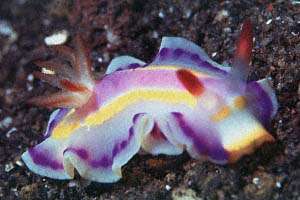

Here is an abbreviated version of a message forwarded by Terry Gosliner to accompany the photos of Thorunna florens from Bali that Rebecca Johnson referred to in her last message. It is from Michael Miller
To: Terry Gosliner & Dave Behrens,
Subject: Bali, Indonesia, October 1998.
Terry/Dave
The trip was very reasonable cost wise, accommodations were great and the manager (Emiko Shibuya) even participated in the great branch hunt of Oct.98. The branch encounters peaked at about the third day and tapered off after that. We dove almost exclusively along a 1000 ft. frontage area that included immediately in front of the resort, the liberty ship wreck, and the wall! All diving was shore entry with the exception of a one day excursion to the northern shore area of Bali. In reflection, branch diversity is great but doesn't match the diversity of Batangas. Of course we use boats in Batangas which expands the hunting
area so thats a qualified opinion.
Brought back a number of specimens which are going into the deep freeze this morning. Will start processing film today but am attaching two pics courtesy of Emiko that will knock your socks off!! No I didn't bring home a specimen of this one. She only saw it once!!
Mike
Michael Miller
mdmiller@cts.com
Gosliner, T., 1998 (Nov 13) Pics of Bali Thor. florens forwarded. [Message in] Sea Slug Forum. Australian Museum, Sydney. Available from http://www.seaslugforum.net/find/301Thanks Terry & Mike. The photos are spectacular. I am pretty sure that the animal from Bali is the same as Thorunna florens from Japan (and Hong Kong). I don't know if the same can be said of the Thailand and Western Australian specimens. .. Bill Rudman
Rudman, W.B., 1998 (Nov 13). Comment on Pics of Bali Thor. florens forwarded by Terry Gosliner. [Message in] Sea Slug Forum. Australian Museum, Sydney. Available from http://www.seaslugforum.net/find/301Thorunna florens-Color variation
November 11, 1998
From: Rebecca Johnson
5 November 1998
Dear Dr. Rudman,
As you know, I am working on the genus Thorunna and of the other small chromodorid genera. I recently received a photo of an animal from Bali that I think may be T.florens(unfortuately there is no specimen). I have your specimen of T. florens from Thailand C.162380 and its radula is quite different from either of the T.florens radulae you have published. This animal has an inner lateral tooth that is shorter and more curved than any of the other lateral teeth, more like T. africana. The animal from Bali is very similar in color to the animal from Hong Kong pictured in your 1990 paper on the C. aureomarginata color group, except it is much brighter in color and has red rhinophores and gills. I was hoping you could post a photo of T. florens from Thailand to help me figure out what I am looking at. I can probably post photos from Bali and the radula if it would be of interest to you.
Thank you very much.
Rebecca Johnson
rjohnson@cas.calacademy.org
Johnson, R., 1998 (Nov 11) Thorunna florens-Color variation. [Message in] Sea Slug Forum. Australian Museum, Sydney. Available from http://www.seaslugforum.net/find/290Dear Rebecca,
I have posted, at the top of this page, photos of the three colour "forms" of Thorunna florens including the one from Thailand you were inquiring about.
The Hong Kong colour form matches the "typical" Japanese specimens well, differing only to the extent that the purple submarginal line is broken up into a string of blotches in most reported Japanese specimens. At this stage I feel the Western Australian specimens have a colour pattern which can easily be derived from the Japanese pattern. In internal anatomy, including radular morphology, the Hong Kong and Western Australian specimens matched the Japanese material.
Concerning the Thailand specimen which you say has a differently shaped first lateral tooth. Until your message I had assumed that it was T. florens because the colour pattern was very similar to Japanese material, apart from the yellow lines being replaced by broader orange bands. One feature of T. florens appears to be the broad orange or yellow band around the anterior end of the mantle. This is present in the Thai specimen although it is difficult to see because the front of the mantle is damaged.
From memory, only two other species of Thorunna have broad orange red anterior mantle bands. By coincidence both are already illustrated in the Forum: Thorunna montrouzieri and Thorunna speciosus . Another species which looks something like the Thai specimen is Thorunna australis which I have just posted a picture of.
This doesn't solve the problem of the aberrant-toothed Thai specimen. I'm afraid I had only one specimen so there is little we can do but wait until more material turns up. Perhaps it represents a consistently distinct species, or perhaps it has an aberrant radula.
Concerning the Bali photo and the radula photo. I would very much like to see them and to include them in the Forum.
Best wishes
Bill Rudman.
